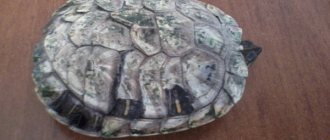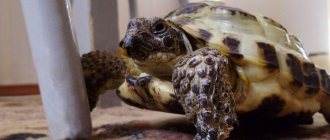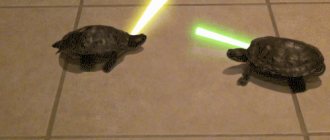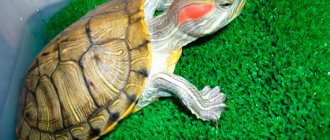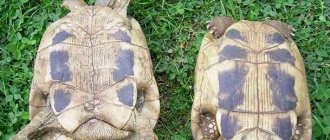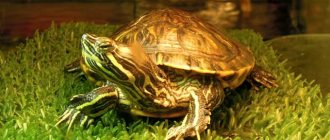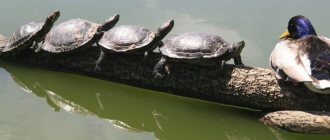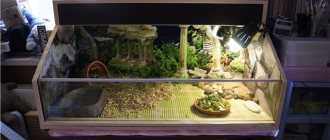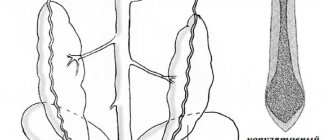In ancient times, there was a belief that the planet Earth rested on the shell of a gigantic turtle. In Chinese mythology, this reptile was one of the sacred animals. Esotericists used turtle shells for predictions. Apparently, the number of plates located along the edge of the “turtle house” contributed to this. The Chinese people depicted this animal on the imperial banners, believing that the turtle protected from fire and war.
In Japan, this mysterious creature was considered a symbol of longevity, wisdom and immortality. Eastern doctors tried to make a miraculous drug from turtle shells that could slow down the aging of the human body. In India, people noticed that the turtle tends to hide in its shell. They identified this feature with meditation and spirituality.
Legend of the Turtle
There is a legend among the Mongolian people that once a turtle moved from north to south. On the way, she met a warrior who shot an arrow at her. The arrow pierced the turtle's shell, killing it.
A forest appeared on the side of the damaged shell, and a sea was formed from the blood of the dying animal - that was the northern side of the world. The flame that finally escaped from the turtle’s throat was called the south side. According to legend, lumps of earth were clamped in the paws of the animal, which subsequently formed the soil with the entire plant world. This is how, according to myth, all directions of the world and the earth originated.
Scientists believe that turtles appeared on Earth 200 million years ago. They have changed little since then. The only thing is that some of them mastered the land, others - the depths of the sea and fresh waters. Researchers suggest that the lifespan of a turtle on earth is over 200 years! The age of this amazing creature can be judged by the scutes on its shell.
Features of breeding turtles at home
By the way, few people know, but the first person who achieved successful results in breeding freshwater turtles at home was not a scientist at all, but a simple amateur who simply loved turtles and devoted all his free time to studying the peculiarities of the life of these creatures. So, if you don’t succeed at something right away, the first time, don’t despair. With proper and careful care and concern for your turtle pets, you will definitely succeed. If not tomorrow, then certainly in a month...
How to determine the sex of a turtle
Determining the sex of a turtle
Well, after such a small inspiring introduction, we invite you to move specifically to practical aspects. So, in order for you to breed turtles, you need a male and female turtle. Accordingly, you must be sure that the turtles you purchased are truly heterosexual. Since expecting offspring from same-sex creatures is a useless idea. Therefore, when purchasing turtles for breeding, or purchasing an additional pair for your male or female, do not make a mistake. You can find out how to determine the sex of a turtle.
By the way, we have a couple of tips for you that will help you determine the sex of the turtle. So,
However, to determine the sex of a turtle, we would recommend that you be guided not only by one sign, but by at least several, then you will have a better chance that you will not be mistaken.
How many turtles do you need to breed?
Once you have decided on the sex of the turtles, do not rush to purchase one male and one female. In this case, if only one pair lives in your terrarium, your chances of success are greatly reduced. Cohabitation of several males and one female will be much more productive. In this case, the turtles must be of the same species (find out about the types of turtles). As for how well they will get along with each other, then, as practice shows, turtles are not conflict creatures, so they will even react calmly to such a family model.
How to stimulate reproduction processes in turtles
You can often hear from turtle owners, especially those who have only a female and a male in their terrarium, that their turtles do not want to reproduce. In this case, it is recommended to use one of the methods of stimulating such processes.
So, in particular, you can house a female and a male, and bring them together only for the mating period - your pets will need time to miss each other.
You can reconsider the climatic conditions of detention - change the temperature, humidity and daylight hours - perhaps the atmosphere in the terrarium was simply not conducive to the reproductive instincts of the turtles. To do this, you can first lower the temperature (within reason, of course) and increase the humidity, while at the same time reducing the length of daylight in the terrarium. Thus, you will put the inhabitants of the terrarium into sleep mode for a while. And, after that, you will make the reverse changes in the reverse order - first extend the duration of daylight hours, then lower the humidity level and, finally, increase the temperature indicator.
To stimulate reproduction, you can also arrange a wintering area for turtles. To do this, place the animals one at a time in small (turtle-sized) linen bags and place them on a layer of sphagnum, covering them with another layer of sphagnum on top. In order to avoid dehydration of turtles, it is recommended to moisten the filler itself daily by spraying from a spray bottle. This artificial wintering can last for 4 weeks. After this, you will need to smoothly bring the turtles out of their sleep state; for this, their wintering boxes will need to be moved to a warm room, and then the sleeping beauties and beauties should be transferred to the terrarium. After a few days, it will be possible to turn on the heating lamp in the terrarium and increase the duration of daylight hours - at least 16 hours a day. Don't forget to adjust the humidity levels as well.
Shell structure
The shell of turtles all over the world consists of two shields: dorsal and ventral. They are connected to each other. The shell has openings for the head, legs and tail. When danger approaches, the turtle hides in its shelter.
Some species of this animal have a soft shell, but it is quite durable. Therefore, a formidable predator will not be able to chew it. The shell serves as real protection for the turtle. After all, by nature she is clumsy and slow, but “a home with you” will always protect and hide her from ill-wishers.
Turtles are divided into sea, river and terrestrial. Scientists count approximately 230 species of these interesting creatures. They have some differences among themselves in color, size and body structure.
For example, land and river turtles are smaller in size than their sea counterparts. All reptiles are extremely heat-loving creatures. Their habitat is the tropics and subtropics.
Only in the very hot deserts of New Zealand and the Pacific coast of South America will travelers encounter turtles. The land species lives in almost all corners of our planet. River turtles and sea turtles are known in Russia.
Head and eyes of a turtle
Aquatic turtles - types, description, care and habitats
The head of almost all turtle species has a small, streamlined shape compared to the body. This is necessary so that the reptile can quickly hide in its shell if it senses danger. Soft-bodied turtles have a sharp muzzle with a nose at the tip. As for the eyes, these animals have good and color vision, which helps them in searching for food and prey.
Important! Turtles have large heads that do not fit under the shell; they never hide on it, not relying on it as their main means of defense. Among them: vulture, sea, big-headed turtle and so on.
Common red-eared species
Pond slider
The most beautiful representative of the turtle world is the red-eared turtle. This is a freshwater turtle that has a shell size of more than 25 centimeters. The beautiful reptile has been growing for many years. The shell of a red-eared turtle reaches a diameter of about 7.5 cm in 1.5 years. Then it continues to grow more slowly, adding 1 cm per year. The shell of the red-eared slider can reach a maximum length of 30 centimeters.
She herself comes from the southeastern part of the United States. Outwardly this is a cute creature. The turtle has scarlet spots on both sides of its head, which is why it received the name “red-eared.” Although in reality she has no ears. Interestingly, the shell of red-eared turtles can change color depending on their age and habitat. In young individuals, light shades predominate; in adults, darker tones, even black, predominate.
Spine
It has cervical, thoracic, lumbar, sacral and caudal sections. Cervical, has eight vertebrae, several anterior ones are connected to form a movable joint. The vertebrae of the body are connected to the ribs. The upper vertebrae, together with the sternum, actually form the chest and cavity, which contains important internal organs. The pelvic bones are attached to the sacral vertebrae. The caudal vertebrae are represented in large numbers; they do not bear any special functional load. The turtle's skull is represented by a large number of bones. It has two sections, cerebral and visceral.
Turtle and common musk turtle
These turtles are commonly mistaken for snapping turtles. The banded turtle is not very common in North Carolina. It is found only along the northwestern border of the state in two counties. The common musk turtle can be found throughout North Carolina.
This turtle also bites when first picked up. There are seven species of sea turtles, which are marine reptiles that need to exhale air to survive. They return to shore to lay eggs, often making long journeys to visit specific beaches each year.
The eyes are located on the side of the head, looking down. These animals eat with the help of a hard beak, which has irregularities similar to teeth. The turtle's head has a fairly streamlined shape, which gives it speed to the marine species.
The turtle's brain has two sections, the head and the dorsal. Despite the fact that the brain is very small in size. Most of the functional load is borne by the spinal cord.
They face many human threats, including entanglement in fishing gear, marine debris, destruction of coastal habitats, poaching of adults and eggs, and climate change. There are also advances in sea turtle conservation. On the coast of Mexico, one community hangs lights in their fishing nets so turtles can avoid them. They found a 50 percent reduction in turtle catches at night, while fish catches actually increased.
Every year, in the same place and time, thousands of Kemp's sea turtles come ashore to nest and lay eggs on the beach. Flatback turtles tend to spend most of their time on the surface of the ocean, often with a bird using their shell as a small landing space, ideal for a break.
Keeping a turtle
Russian wildlife lovers willingly purchase this particular type of turtle. The point is not only in the bright color of the reptile, but also in its unpretentiousness. But there are some features that should be taken into account.
For example, it is a mistake to choose a small terrarium for a red-eared turtle. After all, the reptile will grow up and demand more and more space. You need to stock up on 100-150 liters of terrarimum. It must provide a dry space, and the water level must exceed the size of the turtle's shell.
It is recommended to change the water in the aquarium 1-2 times a week and maintain a temperature of at least +20-26°C. If you neglect these rules, then after a while you can find unhealthy colored spots on the animal’s shell. Experts advise placing the aquarium with the turtle in a sunny place, as the pet loves to bask in the warm rays.
The health of a turtle, including the condition of its shell, directly depends on nutrition. It must be balanced. There is a considerable amount of food for turtles on sale, but not all mineral and vitamin supplements are taken into account.
This will sooner or later affect the health of the reptile. In parallel with this, you can find that the red-eared turtle has a soft shell, which is not its natural feature. You can supplement your diet with finely chopped fresh fish. Moths and earthworms can serve as excellent food additives for turtles.
Do turtles have teeth?
How long do red-eared turtles live at home?
It is worth noting that these reptiles do not have teeth. They have a fairly powerful and hard beak, which they use for biting and tearing food. Instead of teeth, the beak has hard bulges that look like rough gums.
Exotic turtle teeth
Common herbivorous reptiles do not have such sharp protuberances, but have gums that are supplied with rough and pointed edges. They are needed for chewing hard roots, herbs and leaves. The tongue of these animals is involved in chewing and swallowing food, but, unlike other reptiles, they cannot extend it out to display and capture the victim.
Important! Predatory turtles have sharp bulges. Sometimes they reach razor sharpness, which helps them chew and tear the flesh of caught prey without any problems.
Do pet turtles bite?
We can definitely say that these reptiles bite, but in rare cases. Most often this happens due to careless feeding of the animal or as a result of aggression. Even though they do not have teeth, the bite can be very painful. This also applies to domestic miniature species. If we take, for example, a snapping turtle, it can easily bite through a pineapple or a thick turkey drumstick.
Shell - health indicator
Turtle shells often suffer from traumatic damage. Land reptiles are especially prone to this. The cause may be a turtle falling from a height. Sometimes a turtle may be accidentally stepped on or trapped in a door.
That is why the shell of a land turtle should be periodically inspected for cracks, scratches and other changes. If the owner notices spots on the turtle's shell or a suspicious change in color, this may indicate the presence of secondary bacterial and fungal microflora. Such lesions can lead to partial or complete destruction of the shell. If these symptoms occur, you should immediately consult a doctor!
Interesting things about turtles
Many people keep turtles at home: their unpretentiousness and ability to survive for a long time without care make them attractive to wildlife lovers. They are especially popular in the USA, where the law even regulates the most insignificant details related to their maintenance - for example, the transportation of turtles with a shell diameter of less than 10 centimeters is prohibited. And in some states it is not allowed to sell turtles (Indiana), or even keep them in the house (Oregon). In America, there is also such specific entertainment as turtle racing, which attracts thousands of spectators during fairs in the Midwest. Interestingly, two Central Asian turtles were the first living creatures to fly around the Moon on the Soviet Zond-5 spacecraft and return to Earth - this was a few months before the American Apollo flight!
Turtles have become cartoon characters more than once - remember the Soviet “Lion Cub and the Turtle” or the American animated series about the Teenage Mutant Ninja Turtles. In heraldry, this reptile is represented on the coats of arms of English tropical colonial possessions (which is understandable), as well as Spanish and German cities (the southern regions of Germany are within the natural habitat of turtles). Well, finally, let us remember that, according to the ideas of the ancients, it was the great turtle swimming in the World Ocean that was the foundation on which three elephants settled, holding the Earth on their backs.
Softening the shell
Let's look at the reasons why a turtle's shell becomes soft. If this is not due to a natural feature, then most likely, this is due to a lack of calcium in the animal’s body. This also indicates non-compliance with the rules for keeping the turtle, a lack of ultraviolet rays and a lack of vitamin D.
If you notice, for example, that a red-eared turtle has a soft shell, then rush to see a doctor for examination. Only he will be able to say exactly what caused this phenomenon and what needs to be done. Often, owners of reptiles notice spots on the shell of a turtle in the form of algae. If they are mild and there are few of them, then there is nothing to worry about. If the turtle is “overgrown” with such a pattern, you should pay attention to the contamination of the water and lighting. White spots on a turtle's shell may indicate the presence of fungus. Self-medication of reptiles is not recommended. In any case, if spots are noticed on the shell of a red-eared turtle, it is better to consult a herpetologist in time.
How to properly care during shedding period
If you notice that your pet's shell is peeling off on the surface, then this is a clear sign that he is molting. But in order for the reptile to feel comfortable at this time, it is necessary to take some measures to care for it:
- special attention should be paid to nutrition. It should contain components with a high calcium content and other useful substances. This will strengthen the peeling shell;
- Fish and crustaceans should be included in your pet's diet. This food contains all the necessary elements to strengthen bone tissue. This is exactly what will be needed to increase the strength of the exfoliating shell;
- It is recommended to carefully monitor the cleanliness of the amphibian’s home. The fact is that at this time there is severe peeling, and dying particles can seriously clog the water. And contaminated water is an ideal place for the proliferation of various harmful bacteria. It is advisable to change the water regularly, and be sure to install a filter;
- Some owners, to speed up the process, begin to tear off layers by layers themselves, but this is not worth doing. The reptile can easily cope on its own, because the surface layer is easily separated. You can resort to this help only when the process has been delayed and the turtle cannot shed the exfoliating particles on its own;
- Be sure to bathe your pet regularly, this will help remove remaining dirt and prevent rotting. For bathing, use a small container with low sides. Warm water is taken into it and baking soda is added - 1 teaspoon per 1 liter of water. Then the reptile descends into it, its head being on the surface of the water. Bathing is required for 20 minutes.
Leatherback turtle
This reptile is considered the largest turtle in the world. Her body weight ranges up to 600 kilograms, and its length reaches 3 meters. Why does a turtle's shell attract attention? The shell of reptiles of this species consists of interconnected bony plates. But he is not connected to the skeleton. A distinctive feature of the leatherback turtle’s shell is its extremely dense skin! Scientists note that this reptile cannot retract its head into its shell due to the unusual structure of its body.
Another large species is known to science - the giant tortoise. Sometimes it is called gigantic, or Seychelles. The reptile lives on the island of Aldabra. The turtle is interesting for its structure: it has quite powerful legs and a small head relative to its body. Its shell is quite sloping and reaches 130 centimeters.
The ancestors of turtles: what were they like?
Despite the large number of fossil turtle remains found, scientists still cannot say with one hundred percent accuracy who the ancestor of these animals was. Disputes on this issue are still ongoing in the scientific community. But one thing scientists can say with absolute certainty: the first turtle appeared in the Mesozoic era. This animal had only one half of its shell and a mouth full of sharp teeth. Ten million years later, the turtle's shell was fully formed, but its teeth still remained at this time.
It is known that the fossil ancestors of turtles were incredibly large. They reached a length of more than two and a half meters and had a huge tail. In some specimens it reached the same length as the carapace. There were large needle-like growths at the end of the tail, and long curved horns grew on the skull.
At the moment, zoologists know about twenty-six species of turtles, of which twelve exist to this day.
Musk turtle
The musk turtle is the smallest in the world. Its habitats are water bodies of the USA and Canada. This creation of nature weighs a little more than 200 grams. The length of the turtle is about 8 centimeters, the shell reaches about 6-7 centimeters. As a defense, the reptile is capable of emitting a rather unpleasant odor thanks to the liquid that accumulates in the back of its shell. The turtle is omnivorous and unpretentious. Its diet includes small fish and various aquatic vegetation.
Characteristics of the skeleton of the girdles of the front and hind limbs of a turtle
The skeleton of a turtle, the diagram of which is given below, indicates that animals of this species belong to reptiles. They have the bones of the forelimb girdle attached to their spine: the scapula, the clavicle and the crow's formation. They are located in the middle of the chest. The scapula is connected to the carapace by a muscular fold at the location of the first vertebra. The hind limb girdle consists of the pubis, ilium and ischium. They form the pelvis. The tail section consists of many small vertebrae, so it is very mobile.
Roofing turtle
The roof turtle stands out among turtles for its unusual structure. Her homeland is India. The shell of this interesting turtle is about 40 cm long.
The reptile has a keel on its back. Particularly striking is the posteriorly directed tooth on the third vertebral scute. The coloring of the roofing turtle is excellent!
The reptile's belly is reddish-yellow, with distinct black spots. The head and back of the head are highlighted in bright red. The carapace, bordered by a light yellow ribbon, plays with greenish-brown hues.
How was the turtle's skeleton formed?
It is assumed that the ancient ancestors of turtles lived in the Triassic of the Mesozoic era, that is, 220 million years ago. The shell was formed from ribs, and a “dome” of plates gradually grew around it.
One of the ancestors of modern species is Odontochelys semitestacea, which is an aquatic inhabitant and was found in southwest China. She had teeth located on her jaws.
The formation of the shell was not completed: the carapace was formed by expanded ribs, and the plastron was already taking on its modern appearance. The unusual animal was distinguished by a long tail and more elongated eye sockets in the skull. Scientists believe that Odontochelys semitestacea used to live in the seas.
The turtle is a unique chordate animal with a shell. It is thanks to him that the reptile has an unusual arrangement of bones and a somewhat “strange” skeleton. A powerful frame allows the turtle to adapt to life in water and on land. And now the question: does a turtle have a spine is off the agenda.
https://www.syl.ru/article/299865/skelet-cherepah-stroenie-fotohttps://kotsobaka.com/cherepahi/pancir.htmlhttps://homkin.ru/cherepahi/anatomiya-cherepah/skelet.html
